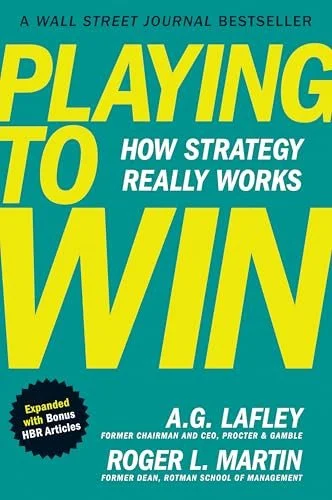Defining Strategy
Just What Does The Term “Strategy” Mean?
Harry Kangis, Co-Founder, Principal and General Manager, One Page Solutions
After almost 25 years of helping myriad clients build strategic plans they will actually use, we remain surprised at how loosely the term “strategy” is often defined:
It is frequently misused as an objective – “our strategy is to sell more product,” or “our strategy is to beat competition.”
It is frequently confused with an annual operating priority – “our strategy is to make our budget forecast,” or “our strategy is to fulfill all our customer orders on time.”
Since we began our One Page Strategic Plan® work in 2001, we have promoted our favored definition of strategy, coined by Roger L. Martin in 1995 when he helped P&G to better focus its $1B+ coffee business:
“An integrated set of choices which positions the firm in its industry, so as to create sustainable advantage relative to competition and superior financial returns.”
Recently, Roger wrote in one of his Playing To Win thought pieces on Medium about the steps he took to make this definition even clearer: “An integrated set of choices that compels desired customer action.”
All of us at One Page Solutions LLC spent the prior decades of our careers, in both for-profit and non-profit organizations, meeting the organizations’ mission goals by making real choices about where to allocate limited resources. The accompanying piece on Playing to Win, below, delves more deeply into the Where To Play and How to Win approach to make strategic choices.
We also have benefited from studying the work of Michael Porter, one of the greatest strategic thinkers of the past century, as well as Roger L. Martin, one of the best strategic thinkers and practitioners today. (See the Resources section at www.ogsp.org to read more.)
Another important distinction when setting strategic priorities for any organization is separating those from annual operating priorities.
At One Page Solutions, here is the test we use to distinguish between the two:
Strategic Priorities – 1) Focused on building future growth/success; 2) Require more significant investment in money, time, and leadership attention; and 3) In most cases, require a good deal of cross-functional collaboration
Operating Priorities – 1) Focused on delivering current year forecast & mission commitments; 2) Projects which deliver continuous improvement across functions; Activity focused on relationships with key stakeholders: owners, customers, consumers, communities, employees
Air traffic controllers need to see all the planes in the sky to do their work. As a strategic leader, you must make all work visible to focus and clarify what must get done to win.
BOOK REVIEW
Playing to Win: How Strategy Really Works
Authors A.G. Lafley (former CEO P&G) and Roger Martin (P&G’s strategic advisor) argue that organizations must clearly define what winning means, develop an integrated set of reinforcing strategic choices, and ensure they have core capabilities and management systems to effectively deploy their choices to influence the actions they want from consumers. Using examples from Lafley’s tenure as former P&G CEO, the authors demonstrate the power of their approach through P&G’s remarkable transformation, where they doubled sales, quadrupled profits, and increased market value by over $100 billion in ten years.
Their approach centers on five integrated strategic choices that create a winning playbook:
What is our winning aspiration? - Defining success in both words and numbers
Where will we play? - Choosing specific markets and segments
How will we win? - Determining a distinctive competitive advantage
What capabilities must we have? - Building necessary organizational strengths
What management systems are required? - Creating a repeatable cadence to deploy, assess, adjust and renew the strategic plan
The framework works for organizations of all sizes, proving that strategic success stems from disciplined decision-making rather than sophisticated complexity. The difference between playing the game and winning is in making deliberate strategic choices and consistently supporting them with aligned actions.
CLIENT FOCUS:
Cincinnati Zoo and Botanical Gardens
Clients of One Page Solutions will readily recognize the Cincinnati Zoo and Botanical Garden as a long-time client and case study we share in our engagements. This year the Zoo turns 150, and we wanted to spotlight one dimension of their One Page Plan® that has been key to their relevance and longevity.
Beginning in 2010, the Zoo made an intentional commitment to strengthen its environmental sustainability. In developing their first One Page Plan® they prioritized establishing the Zoo as a leader in conservation and eco-friendly practices as one of their strategic planks. This strategic choice led the Zoo to:
· Launch its "Plant Domes" project, incorporating energy-efficient designs and sustainable materials to create environmentally responsible exhibits
· Reduce water usage through innovative irrigation systems and rainwater harvesting
· Adopt renewable energy sources, including solar panels, to power its operations
· Reduce waste by initiating composting and recycling programs
· Promote education and community outreach to further environmental awareness
Their commitment and work have been noticed.
The Zoo achieved LEED certification for several new facilities, in recognition of its commitment to green building standards. They received the Green Award from the Ohio Environmental Protection Agency and recognition from the Association of Zoos and Aquariums for their sustainability leadership. They are now frequently cited as The Greenest Zoo in America.
We are proud to have worked with the Cincinnati Zoo and Botanical Gardens for almost two decades, and salute their long-time CEO, Thane Maynard, for his outstanding leadership as he steps down from that role and becomes the Executive Chairman of the Board in January 2026.



